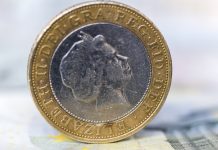The pound and the euro were evenly matched on Monday, both broadly in favour and therefore with limited movement between them. The pound euro exchange rate hovered close to its opening price and ended the session flat on the day at €1.1433.
| What do these figures mean? |
|---|
|
When measuring the value of a pair of currencies, one set equals 1 unit and the other shows the current equivalent. As the market moves, the amount will vary from minute to minute. For example, it could be written: 1 GBP = 1.13990 EUR Here, £1 is equivalent to approximately €1.14. This specifically measures the pound’s worth against the euro. If the euro amount increases in this pairing, it’s positive for the pound. Or, if you were looking at it the other way around: 1 EUR = 0.87271 GBP In this example, €1 is equivalent to approximately £0.87. This measures the euro’s worth versus the British pound. If the sterling number gets larger, it’s good news for the euro. |
After a crucial week for the pound in the previous week, this week is considerably quieter. Investors continue to digest developments regarding both Brexit and Bank of England monetary policy, which are underpinning sterling.
Firstly, a Brexit deal has been agreed and voted on by EU leaders, meaning increased probability of a smooth transition for UK business when Britain leaves the EU. This is considered pound positive. Secondly the Bank of England have increased investor expectations of a May interest rate rise, which is also boosting the pound.
| Why do raised interest rates boost a currency’s value? |
|---|
| Interest rates are key to understanding exchange rate movements. Those who have large sums of money to invest want the highest return on their investments. Higher interest rate environments tend to offer higher yields. So, if the interest rate or at least the interest rate expectation of a country is relatively higher compared to another, then it attracts more foreign capital investment. Large corporations and investors need local currency to invest. More local currency used then boosts the demand of that currency, pushing the value higher. |
This week the UK economic calendar is particularly light. Market participants will now look out towards the UK GDP later in the week. Analysts are expecting that economic growth will slow down from 0.5% to 0.4% quarter on quarter and from 1.8% to 1.4% year on year. This would mark a considerable slow down for the economy, which would position the UK ad one of the slowest growing major economies. This could impact negatively on the pound, despite other more positive backdrops.
Euro Supported By Rate Rise Hopes
The euro was broadly in favour on Monday, receiving a boost from European Central Bank Governing Council member Jens Weidmann. Mr Weidmann reassured the market that he believed that an interest rate rise would be the cards for mid-2019. This is a welcomed relief for euro traders, who have been consistently plagued with a very conservative sounding ECB President Mario Draghi.
After a strong previous secession, the euro could reverse its gains today as investors look towards consumer sentiment for the eurozone. Sentiment has been falling across the eurozone and Germany in recent weeks as momentum in the economy appears to be slowing. Analysts are predicting that eurozone economic confidence will have fallen slightly in March to 113.3 from 114.1 in February. Should the drop be larger, the euro could skid lower.
| Why does poor economic data drag on a country’s currency? |
|---|
| Slowing economic indicators point to a slowing economy. Weak economies have weaker currencies because institutions look to reduce investments in countries where growth prospects are low and then transfer money to countries with higher growth prospects. These institutions sell out of their investment and the local currency, thus increasing supply of the currency and pushing down the money’s worth. So, when a country or region has poor economic news, the value of the currency tends to fall. |
|
This article was initially published on TransferWise.com from the same author. The content at Currency Live is the sole opinion of the authors and in no way reflects the views of TransferWise Inc. |





